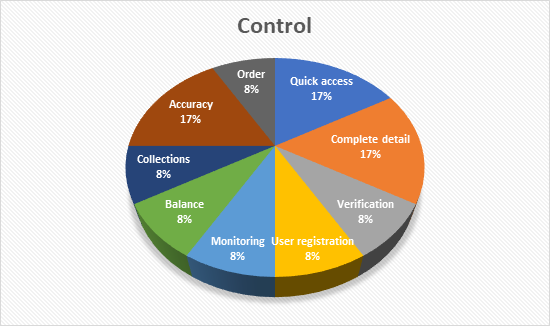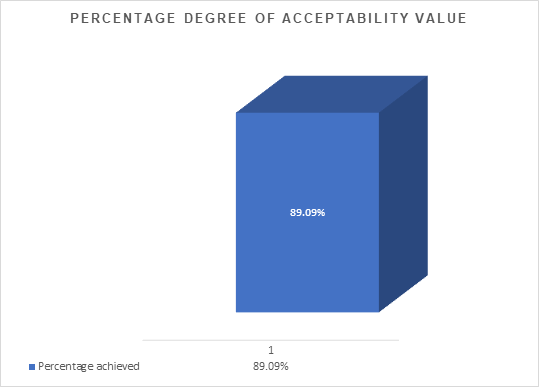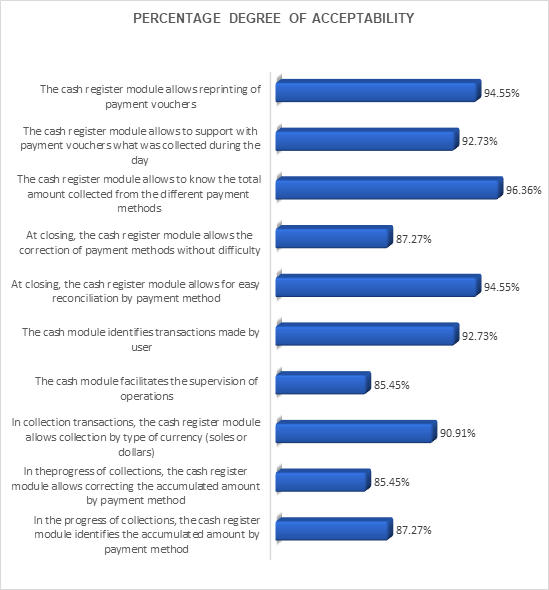Services on Demand
Journal
Article
Indicators
-
 Cited by SciELO
Cited by SciELO
Related links
-
 Similars in
SciELO
Similars in
SciELO
Share
Industrial Data
Print version ISSN 1560-9146On-line version ISSN 1810-9993
Ind. data vol.24 no.2 Lima July/Dec. 2021 Epub Dec 31, 2021
http://dx.doi.org/10.15381/idata.v24i2.19565
Production and Management
Implementation of an Enterprise Resource Planning System to Improve the Productivity of Cash Register Collections of an Important Clinic in the City of Lima
3*Public accountant from Universidad Nacional del Callao (Lima, Peru). Currently working as professor at Instituto CERTUS (Lima, Peru). Email jinfantesl@certus.edu.pe
2 Degree in Computer Science from UNMSM (Lima, Peru). Currently working as professor at UNMSM (Lima, Perú). Email smoquillazah@unmsm.edu.pe
The purpose of this study is to show the results obtained after the implementation of an enterprise resource planning system in an important clinic in the city of Lima. Quantitative and qualitative techniques were applied to determine the improvements or benefits that arose from implementation. The results are shown in tables and graphs that were prepared based on the information obtained from the users of the ERP system/cash register module. It is concluded that a better control of cash register collections contributes to better productivity performance and better customer service.
Keywords: ERP system; Msante system; automation; SUNAT; control.
INTRODUCTION
Companies need to be aligned with information systems to achieve innovation, competitivity and a better position in the market. This is possible through the application of agile processes and activities that enable operational efficiency and effectiveness, which result in the acquisition of optimal information for good decision-making and continuous improvement.
This study presents the knowledge acquisition of the enterprise resource planning (ERP) systems implemented at a clinic in the city of Lima. This study also shows the way in which these systems contribute (1) to the work executed by each employee or user, since ERP is an easy and comfortable work tool for good performance of the tasks assigned, and (2) to production improvements of the clinic through information integration.
When observing and analyzing the enterprise resource planning system implemented at the clinic, it becomes evident that it enables planning each activity in an orderly manner while respecting established procedures; improves the flow of documents; and optimizes time to comply with the requirements of supervisorial bodies, such as SUNAT (Peruvian National Superintendency of Tax Administration). In this way, control of the cash process is achieved, which has an impact on the results of money collections.
ERP systems were created for companies that handle manufacturing or stock inventories; however, the novelty of this study resides in the fact that it shows that this system can also be applied to a service company. In the same way, this study will make it possible to expand knowledge of the ERP system by proposing its applicability in a company in the health services sector, which is demonstrated by processing the information provided by the users of the clinic's cash register module on the benefits from the ERP system.
According to Duke, Navarro, Díaz, Pérez, and Vargas-Lombardo (2016), “los principales retos que presentan las organizaciones hoy, es enfrentar los constantes cambios al mercado actual, con la necesidad de implementar sistemas que ayuden a la buena comunicación e integración entre las distintas áreas de una organización [the main challenges faced by the organizations these days is to face the continuous changes in the current market and the need to implement systems that help good communication and integration among the different areas of an organization]” (p. 87).
Therefore, the need arises to integrally organize activities and processes, since it is necessary for each department, division or area of every business to always maintain fluid and accurate communication. At the same time, each operational area must interact with each unit of the organization to search for improved control that enables decision-making based on correct information.
Undoubtedly, the proper functioning of the ERP system will depend on an adequate configuration, the predisposition of the personnel, as well as their experience. Given the investment cost that this type of system requires, there is no doubt that benefits will be obtained in the medium and long term. Therefore, improvements must be made on the proper processing or transfer of information so that the relevant or specialized area has the correct data; otherwise, the information provided will not be accurate.
In view of the above, the general objective was “to implement an ERP system to improve the control of cash register collections in an important clinic located in the city of Lima”. Likewise, the specific objectives were “to demonstrate that the automation of operations through the Spring ERP system/cash register module will contribute to the control of cash register collections in an important clinic located in the city of Lima”, “to corroborate that the improvement of the information process by means of the Spring ERP system/cash register module will increase the control of the cash register collections of an important clinic located in the city of Lima” and “to prove that cash counts by means of the Spring ERP system/cash register module will generate an adequate control of the cash register collections of an important clinic located in the city of Lima”.
An advantage of the ERP system is that it contributes to the fulfilment of objectives through parameterization.
As defined by Suárez (2016):
La parametrización de un ERP permite adaptar el funcionamiento del sistema a las necesidades concretas de cada empresa, así como incorporar nuevas funciones o modos de funcionamiento a medida que la empresa en cuestión lo requiere, sin requerir de desarrollos específicos o a medida del cliente [The parameterization of an ERP allows to adjust the functioning of the system to the specific needs of each company and also to incorporate new functions or modes of operation as the company in question requires it, without requiring specific or client-customized developments]. (p. 25)
GENERAL HYPOTHESIS
The implementation of an ERP system improves the control of the cash register collections in an important clinic located in the city of Lima.
SPECIFIC HYPOTHESES
The automation of operations by means of the Spring ERP system/cash register module will contribute to the control of cash register collections in an important clinic located in the city of Lima.
The improvement of the information process by means of the Spring ERP system/cash collection module will increase the control of cash register collections in an important clinic located in the city of Lima.
The cash counts by means of the Spring ERP system/cash module will generate an adequate control of cash register collections in an important clinic located in the city of Lima.
JUSTIFICATION
According to Hernández, Carreño, Sandoval, Estrada and Ignacio (2016), “desde hace más de tres décadas los Sistemas Enterprise Resource Planning (ERP) en inglés, conocidos como Sistemas de Planificación de Recursos, Empresariales (sic), han otorgado alta competitividad al mundo empresarial [for more than three decades, enterprise resource planning (ERP) systems have made the business world highly competitive]” (p. 234). Based on this, the implementation of an ERP system in an important clinic located in the city of Lima became necessary to improve the processes that contribute to the control of cash collections or cashing through the cash register module. Likewise, this implementation would contribute to the improvement of customer or patient care and information procedures and would eliminate manual procedures to facilitate the cashier's work, provide correct information and optimize accounting department activities so that it handles correct financial information.
In words of Farfán (2020), “a través de la automatización de la gestión por procesos, las organizaciones pueden tener un mejor funcionamiento, aumentando la eficiencia de las mismas, lo cual representa una ventaja competitiva [through the automation of process management, organizations function better and their efficiency increase, which represent a competitive advantage]” (p. 36).
The information system makes it possible to design better user-friendly IT structures for a good review and supervision of operations, which allows the accounting department to verify each operation and to ensure compliance with the rules of the supervisory and control bodies.
According to Fernández (2015):
El arqueo de caja “consiste en la realización de una [sic] análisis de la [sic] transacciones de efectivo que se han producido en al [sic] empresa en un lapso de tiempo determinado”. La finalidad del mismo es comprobar si existen diferencias entre el efectivo contabilizado y el recuento de billetes, monedas y cheques físicamente que tenemos en nuestra caja. Hemos de tener en cuenta que todo registro contable debe estar soportado documentalmente, de modo que cualquier error u omisión debe ser fácilmente detectable [The cash count “consists of carrying out an analysis of the cash transactions that have taken place in the company over a given period of time”. Its purpose is to check whether there are any differences between the cash accounted for and the physical count of notes, coins and cheques in our cash register. It should be borne in mind that all accounting records must be supported by documentation, so that any errors or omissions should be easily detectable]. (p. 94)
During the cash count documentation is checked and controlled, which makes it possible to accurately account for the different payment methods. The cash count is included in an ERP system in order to comply with the banking and the payment of the tax on financial transactions (ITF), as stipulated by Law 28194, in force since 2004.
Mayorga, Espinosa, López and Chango (2020) state that “los sistemas de información permiten a la organización captar, identificar y comunicar de forma adecuada el plazo permitido al personal para afrontar sus responsabilidades. La comunicación debe ser fluida en todo el conjunto de la institución [information systems allow the organization to capture, identify and adequately communicate the information related to the time allowed to staff to meet their responsibilities. Communication must be fluid throughout the institution]” (p. 62).
According to Hurtado, Arroyo and Guzmán (2019), “el control interno puede ayudar a que una entidad consiga sus objetivos de rentabilidad y rendimiento y a prevenir la pérdida de recursos [internal control can help an entity to achieve its profitability and performance objectives and prevent the loss of resources]” (p. 6).
The implementation of the ERP system has managed to keep an important private clinic in the city of Lima -which has a history of more than 150 years and has three locations in the districts of Lima, Chorrillos and Surco- in a leading position.
ENTERPRISE RESOURCE PLANNING SYSTEMS
to Riascos and Arias (2016), “la decisión de implementar un sistema de información ERP le facilita a la organización desarrollar sus procesos administrativos de forma eficiente y eficaz [the decision to implement an ERP information system makes it easier for the organization to develop its administrative processes efficiently and effectively]” (p. 289).
The ERP system is an adaptable program that provides optimal management and operational results, since it makes it possible to make the most of the resources the system provides in an integrated manner. This system allows to configure or shape the various tasks in a structured manner according to the user’s profile; in this way, it provides reliable information that is backed up by a database platform.
According to Núñez (2016):
Típicamente, un sistema ERP es un sistema de información integrado en la forma de un paquete de software compuesto por varios módulos, tales como producción, ventas, finanzas y recursos humanos, que nos aporta una integración de datos horizontales a lo largo de la organización y a través de sus procesos de negocio. Esos paquetes pueden ser personalizados de forma que respondan a las necesidades específicas de la organización [Typically, an ERP system is an integrated information system in the form of a software package that consists of several modules, such as production, sales, finance and human resources, which provides horizontal data integration throughout the organization and across its business processes. These packages can be customized to meet the specific needs of the organization]. (p. 7)
Moreover, Oliva, Ortigoza and Méndez point out “Los sistemas ERP son soluciones de software de gestión de información que se ocupa de las necesidades de las empresas de manera integral a través de la automatización de procesos operativos [ERP systems are information management software solutions that address the needs of companies in a comprehensive manner through the automation of operational processes]” (2012, p. 2, as cited in Guerrero, Marín and Bonilla, 2018, p. 185).
According to Suárez (2016), “podemos definir un sistema ERP como un software integrado de gestión empresarial, compuesto por un conjunto de módulos funcionales (logística, finanzas, recursos humanos, etc.) susceptibles de ser adaptados a las necesidades de cada cliente [we can define an ERP system as an integrated business management software that consists of a set of functional modules (logistics, finance, human resources, etc.) that can be adapted to the needs of each client]” (p. 19).
Automation of an ERP system is achieved when activities are carried out in a simple manner in the shortest possible time; however, unless the activities and processes are clear, the results obtained will remain unchanged.
It is essential to consider the accounting area within an ERP system since it is an area where information is centralized. Thus, accounting participation is essential in each area or business unit as it contributes to the improvement of operational designs or structures; it facilitates the flow of accounting information and makes it reliable.
According to information published in ESAN (September 14, 2018), “el sistema de planificación de recursos empresariales o enterprise resource planning (ERP) es un software desarrollado para gestionar los principales procesos empresariales [the enterprise resource planning (ERP) system is a software developed to manage the main business processes]”.
According to Hernández, Baez and Córdova (2018), “los sistemas ERP (Enterprise Resource Planning) se han definido como un sistema global de planificación de los recursos y de gestión de la información que de forma estructurada pueden satisfacer la demanda de las necesidades de gestión de la empresa [ERP (Enterprise Resource Planning) systems have been defined as global systems of resource planning and information management that can meet the demand of the company's management needs in a structured manner]” (p. 2).
Oltra (2012) states that “en su continua evolución, han pasado de ser una mera herramienta de trabajo, a ser un elemento competitivo y estratégico, llegando incluso a generar nuevos modelos de negocio basados en su desarrollo [in their continuous evolution, [ERPs] have gone from being a simple work tool to being a competitive and strategic element that even generates new business models based on their development]” (p. 5).
METHODOLOGY
This research is applied and descriptive. It is applied because it will determine and verify the benefits of the implementation of the ERP system in a company in the health sector; and it is descriptive because it mentions the attributes of the ERP system implementation in the accounts receivable of the cash register module.
According to Lozada (2014), applied research aims to generate knowledge with direct and medium-term application in society or in the productive sector.
For Hernández, Fernández and Baptista (2010)
con frecuencia, la meta del investigador consiste en describir fenómenos, situaciones, contextos y eventos; esto es, detallar como son y se manifiestan. Los estudios descriptivos buscan especificar las propiedades, las características y los perfiles de personas, grupos, comunidades, procesos, objetos o cualquier otro fenómeno que se someta a un análisis [the researcher often aims to describe phenomena, situations, contexts and events, that is, to detail what they are like and how they are shown. Descriptive studies seek to specify the properties, characteristics and profiles of people, groups, communities, processes, objects or any other phenomenon that is subjected to analysis]. (p. 80)
As for the research design, it is non-experimental since the variable, the object of study, will not be manipulated.
Data collection instruments such as interviews and surveys were applied to the users of the Spring ERP system/cash register module.
In the case of the interviews, performance measurements and comparisons were applied to the Spring ERP system and the Msante system to determine the number of patients that a user could attend to in each case and thus determine the improvement with the ERP system.
In the case of the surveys, the benefits of implementing the Spring ERP system/cash register module were tested, corroborated, and demonstrated.
RESULTS
The following Tables and Figures represent the results obtained from the fieldwork of the independent variable applied to the universe of fifteen users of the cash register module, through interviews and surveys.
The unit of measurement used was the time (minutes) required by both the Spring ERP system and the Msante system to attend to a patient.
Also, to determine the number of patient services supported by each system, the answers obtained from the users interviewed were averaged. For example, in question 1 of the interview, the following was stated: “Has the Spring ERP system improved operations by reducing or eliminating manual work? How much time did you spend per patient in each system?”
Thus, the time needed per patient in each system was determined, which is reflected in Table 1:
Table 1. Time Spent by User in Each System per Patient.
| User | Spring ERP System | Msante System |
|---|---|---|
| User 1 | 4 minutes | 10 minutes |
| User 2 | 3 minutes | 30 minutes |
| User 3 | 3 minutes | 20 minutes |
| User 4 | 5 minutes | 30 minutes |
| Sum of time spent | 15 minutes | 100 minutes |
| Average time spent per patient | 3.75 minutes | 22.50 minutes |
Source: Prepared by the author.
It must be considered that an hour equals sixty minutes; therefore:
Spring = 60/3.75 = 16 patients per hour
Msante = 60/22.50 = 2.66 patients per hour
Man-hours during the week are also included, which are 12 work hours from Monday to Saturday. Sundays were not considered since they are not working days.
After applying these calculations, the following results are obtained:
Total hours spent per cashier/user in a day = 12 hours
Total working days = 26 days
Total hours worked in a month (26 days x 12 hours) = 312 hours
Table 2 details the degree of efficiency according to the time it takes a user to run each system when attending to a patient; first, it shows the minutes it takes per patient, then, the number of patients attended per hour and per month.
Table 2. Patient Care Efficiency Analysis for Each System.
| System | Minutes/patient | Patients/hour | Patients/month |
|---|---|---|---|
| Spring ERP | 3.75 | 16.00 | 4992 |
| Msante | 22.50 | 2.66 | 830 |
Source. Prepared by the author.
The calculation per month is obtained after the following procedure:
Spring = 16 patients x 312 hours = 4992 patients.
Msante = 2.66 patients x 312 hours = 830 patients.
Figura 1 shows the results of monthly services per user and per system. The current Spring ERP/cash register module shows an improvement in the work per cashier, since it increases its monthly throughput by more than 4000 patients, while the Msante system only allowed up to 830 patients per user.
The comparison shows a percentage increase of 501.45%.
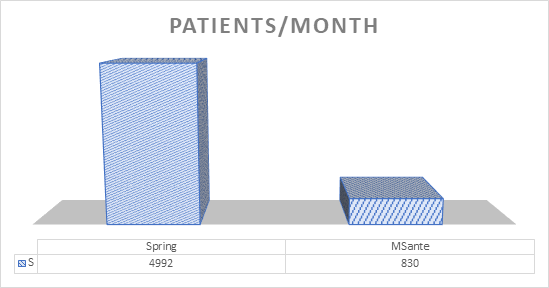
Source: Prepared by the author.
Figure 1. Performance analysis of each system with respect to the number of patients served per month.
Based on interviews conducted, Table 3 shows the efficiency based on the time a user spent working in each system by examining the collection capacity per patient in minutes, hours, and month.
Table 3. Analysis of Cash Register Collection Efficiency.
| System | Minutes/patient | Patients/hour | Patients/month |
|---|---|---|---|
| Spring | 2.75 | 21.82 | 6808 |
| Msante | 8.50 | 7.06 | 2203 |
Source: Prepared by the author.
Figure 2 shows the throughput in the number of patients served that each system could offer per cashier in the cash register collection task. The ERP system improves the monthly service capacity by serving up to 6808 patients, while the previous system supported up to 2203 patients, which translates into a percentage increase of 209.03%, as detailed below:
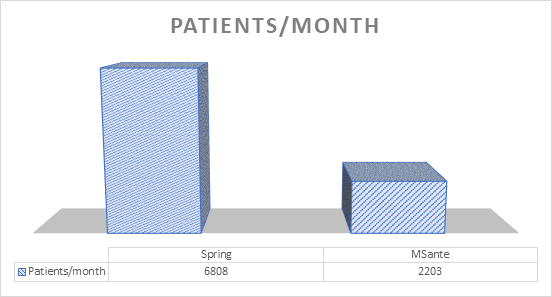
Source: Prepared by the author.
Figure 2. Throughput analysis of patient servings offered by each system per cashier in the cash collection task.
Likewise, when asked how this ERP system contributed to the control, the following results were obtained from the most experienced users, who established nine benefits of this system Figura 3:
The dependent variable was also analyzed to measure the productivity of each computer program, selecting four users of the cash module with knowledge of both systems and who remained in the clinic after the activation of the new system.
According to Argota and Argota (2018) “La prueba t-Student es una de las más utilizadas para la comparación de dos muestras en diferentes escenarios de interés [The t-Student test is one of the most commonly used tests to compare two samples in different scenarios of interest]” (p. 2).
The scenarios were determined based on the general hypothesis “The implementation of an ERP system improves the control of the cash register collections in an important clinic located in the city of Lima”.
The hypothesis was tested by means of the t-Student test; the minutes spent in serving each patient were examined before and after the implementation, as shown in Table 4:
Table 4. Analysis of Service Samples in Minutes per Patient.
| User | Pre implementation | Post implementation | 𝐝 |
|---|---|---|---|
| 1 | 10 | 4 | 6 |
| 2 | 30 | 3 | 27 |
| 3 | 20 | 3 | 17 |
| 4 | 30 | 5 | 25 |
Source: Prepared by the author.
Where:
H0 = µd ≤ 0
H1 = µd > 0
After denoting:
H0 = Does not improve the control of cash register collections.
H1 = Improves the control of cash register collections.
Also:
If p-value < α → H0 is rejected.
If p-value ≥ α → H0 is accepted.
Based on the information in Table 4, the following results of the hypothesis testing analysis are obtained:
Calculation of the mean: d = 18.75
Users: n = 4
Degree of freedom: df = (n-1) = 3
Standard deviation: Sd = (𝑑1−𝑑)^2/𝑛−1 = 9.53502316
Test statistic: t = d Sd/√n = 3.93286931
Critical value: t(1-α)(n-1) = 2.35336343
Significance level: α = 0.05 → 5%
p-value: 0.01463716
Decision: The null hypothesis must not be used.
After analyzing the hypothesis test, it was verified that the test statistic is greater than the critical value and the p-value result is less than the α value; therefore, the null hypothesis (H0) is rejected, and the alternative hypothesis (H1) is accepted. In addition, it was observed that the mean is 18.75, so the skewness is to the right.
Moreover, other types of analysis were taken in order to demonstrate the hypotheses, in which post-implementation improvements were corroborated by means of surveys conducted with ERP system/cash register module users, who gave positive responses regarding the implementation.
Measurement scales were established to determine the degree of acceptability; the results are shown in Table 5:
Table 5. Measurement Scores and Value Scale.
| Determination | Score | Percentage Degree of Value |
|---|---|---|
| Excellent | 5 | 81 - 100% |
| Very good | 4 | 61 - 80% |
| Good | 3 | 41 - 60% |
| Fair | 2 | 21 - 40% |
| Poor | 1 | 0 - 20% |
Source: Prepared by the author.
The general hypothesis was tested through surveys applied to 11 users of the cash register module. This test obtained an average score of 49 points out of 55, representing 89%, which showed that the implementation of the ERP system in the clinic is acceptable, as shown in Figure 4:
Additionally, to determine its degree of acceptability, the three specific hypotheses with their respective indicators were contrasted.
The first specific hypothesis elaborated was “The automation of operations by means of the Spring ERP system/cash register module will contribute to the control of cash register collections in an important clinic located in the city of Lima”.
Eight indicators were established; the acceptability measure of each one exceeded 80%, which resulted in the first specific hypothesis being accepted, as shown in Figure 5:
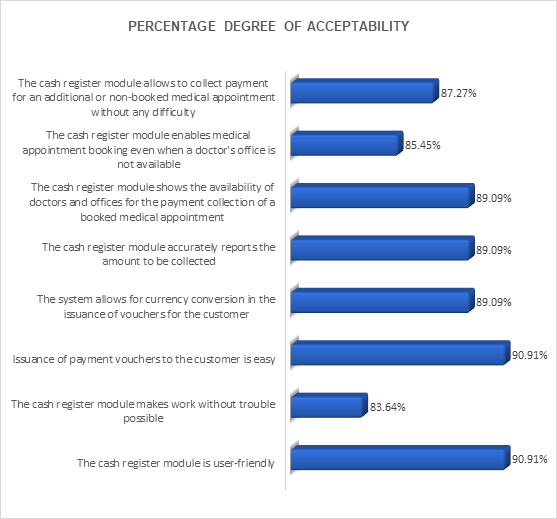
Source: Prepared by the author.
Figure 5. Acceptability indicators of the first specific hypothesis.
The second specific hypothesis elaborated was “The improvement of the information process by means of the Spring ERP system/cash module will increase the control of cash collections in an important clinic located in the city of Lima”.
Six indicators were established; the acceptability measure of each one exceeded 80%, which resulted in the second specific hypothesis being accepted, as shown in Figure 6:
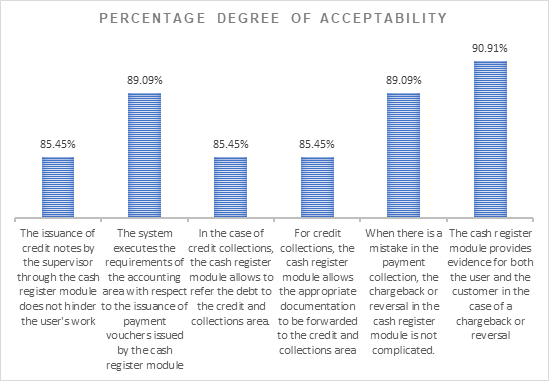
Source: Prepared by the author.
Figure 6. Acceptability indicators of the second specific hypothesis.
The third specific hypothesis elaborated was “The cash counts by means of the Spring ERP system/cash register module will generate an adequate control of cash register collections in an important clinic located in the city of Lima”.
Ten indicators were established; the acceptance measure of each one exceeded 80%, which resulted in the third specific hypothesis being accepted, as shown in Figure 7:
DISCUSSION
Once the results of this research, obtained from field work through surveys and interviews, have been presented, it is corroborated that the implementation of an ERP system for the improvement of control has been successful, which is reflected in the degree of acceptability.
Undoubtedly, the use of the ERP system has resulted in significant changes in the clinic, since improvements were observed in maximizing productivity and a better support and service platform.
The automation, the improvement or ordering of the information processes and the various cash register reports for an adequate cash count have improved control and have been pleasantly received by the cash register users, since they have shown that the attention times have reduced, and users are able to complete their work at the established time.
CONCLUSIONS
The implementation of an ERP system in the clinic has given the expected results, as it has been demonstrated, since it improves aspects not only related to cash register collection control, but related to service times per patient, activities, and processes, since it is a system adaptable to the environment.
The implementation of the ERP system in the clinic has allowed to discover that this system offers a capacity or support platform for the maximum use of resources, since it is possible to optimize time and enhance the operation of users.
The automation of activities through the Spring ERP/cash register module has proven to be user-friendly, allowing users to perform their tasks without difficulty, facilitating the issuance of payment vouchers and currency conversion and contributing to the accuracy of collections; it also provides information on the availability of doctors and offices and enables the reservation and payment collection of medical appointments not booked on time.
The improvement of the information process through the Spring ERP system/cash register module makes it possible that the issuance of credit notes by supervisors does not hinder the work of the users; it has made it possible to avoid incidents with the accounting area; it makes it easier to transfer the documentation of a debt, or credit collection, to the credit and collection area; and it leaves evidence of transaction rebates.
The Spring ERP system/cash register module allows a better functioning of the progress of collections, since it allows the identification of the collected amount according to the payment method; it allows the correction of payment methods without difficulty; it facilitates the collection transactions by type of currency; it facilitates the cash supervision; and it allows that a reconciliation and presentation report is generated at cash closing. In addition, this system has contributed to improved cash reconciliation since it allows to adjust and correct payment methods. As for the issuance of the reconciliation reports, the system makes it possible to know the total collected by payment method, to adequately support each operation and to print vouchers that were not printed at the time of issuance.
REFERENCIAS BIBLIOGRÁFICAS
Argota, G., y Argota H. (2018). Aplicación de la prueba t-Student para la competencia técnica y trazabilidad analítica: ejemplo de estudio. Campus, 23 (26), 145-150. Recuperado de https://doi.org/10.24265/campus.2018.v23n26.04 [ Links ]
Duke, V., Navarro, M., Díaz, G., Pérez, Y., y Vargas-Lombardo, M. (2016). Exploración en los sistemas CRM/ERP como estrategia en el sector PYMES. Revista de Iniciación Científica, 2(2), 86-94. Recuperado de https://revistas.utp.ac.pa/index.php/ric/article/view/1251/1414 [ Links ]
ESAN. (14 de setiembre de 2018). El sistema ERP en la gestión de proyectos. Recuperado de https://www.esan.edu.pe/apuntes-empresariales/2018/09/el-sistema-erp-en-la-gestion-de-proyectos/ [ Links ]
Farfán, J . (2020). La implementación de un sistema automatizado reduce los tiempos de atención en los procesos aplicables a la ventanilla única de turismo en la Municipalidad Provincial del Callao. Industrial Data, 23(2), 31-37. Recuperado de http://dx.doi.org/10.15381/idata.v23i2.15566 [ Links ]
Fernández, A . (2015). Gestión y Control administrativo de las operaciones de caja. Madrid, España: Editorial Elearning S.L. [ Links ]
Guerrero, A., Marín, M., y Bonilla, D. (2018). Erp como alternativa de eficiencia en la gestión financiera de las empresas. Revista Lasallista de Investigación, 15(2), 182-193. Recuperado de https://doi.org/10.22507/rli.v15n2a14 [ Links ]
Hernández, I., Báez, P., y Córdova, J. (2018). Desarrollo de software de simulación ERP para herramienta didáctica en el proceso de enseñanza-aprendizaje. Revista de Tecnologías de la Información, 5(17), 1-8. Recuperado de https://www.ecorfan.org/bolivia/researchjournals/Tecnologias_de_la_Informacion/vol5num17/Revista_de_Tecnolog%c3%adas_de_la_Informaci%c3%b3n_V5_N17_1.pdf [ Links ]
Hernández, R., Fernández, C., y Baptista, L. (2010). Metodología de La Investigación. México D.F, México: McGraw-Hill/Interamericana Editores S.A de CV. [ Links ]
Hernández, J., Carreño, M., Sandoval, J., Estrada, I., y Ignacio, R. (2016). Propuesta de criterios de evaluación en la implementación de ERP’s en instituciones de educación superior. Pistas Educativas, 38(122), 232-243. Recuperado de http://itcelaya.edu.mx/ojs/index.php/pistas/article/view/679 [ Links ]
Hurtado, E., Arroyo, N., y Guzmán, F. (2019). El Control interno y la importancia de su aplicación en las compañías. Revista Observatorio de la Economía Latinoamericana, (agosto 2019). Recuperado de https://www.eumed.net/rev/oel/2019/08/control-interno-companias.html [ Links ]
Lozada, J. (2014). Investigación aplicada: Definición, propiedad intelectual e industria. CienciAmérica 3(1), 34-39. Recuperado de http://cienciamerica.uti.edu.ec/openjournal/index.php/uti/article/view/30 [ Links ]
Mayorga, M., Espinosa, M., López, A., y Chango, M. (2020). Control interno para el área de cajas en Cooperativas de Ahorro y Crédito. Caso de estudio: Cooperativa de Ahorro y Crédito Indígenas Galápagos Ltda. Visionario Digital, 4(2), 57-80. Recuperado de https://doi.org/10.33262/visionariodigital.v4i2.1215 [ Links ]
Núñez, R. (2016). Software ERP. Análisis y Consultoría de Software Empresarial. Madrid, España: IT Campus Academy. [ Links ]
Oltra Badenes, R. (2012). Sistemas Integrados de Gestión Empresarial. Evolución histórica y tendencias de futuro. Valencia, España: Universitat Politècnica de València. [ Links ]
Riascos, S., y Arias, V. (2016). Análisis del impacto organizacional en el proceso de implementación de los Sistemas de Información ERP -- Caso de estudio. Entramado, 12(1), 284-302. Recuperado de http://dx.doi.org/10.18041/entramado.2016v12n1.23127 [ Links ]
Suárez, C. (2016). Guía Práctica. Software de gestión empresarial. Madrid, España: Edisa. [ Links ]
Received: February 12, 2021; Accepted: July 05, 2021











 text in
text in 


